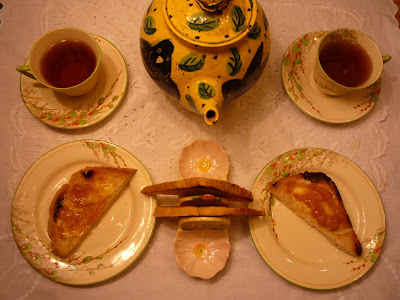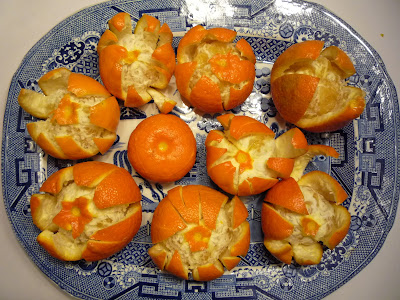Although syllabub puddings in literature are often associated with Wedding feasts they are delicious at any time of year and particularly in the Winter months, imbued with the very essence of festive cheer. The version pictured below is a syllabub coupe made with layers of medlar purée, rose hip syrup, medlar flavoured and plain syllabub and dark chocolate.
However, nothing beats a simple syllabub to accompany the final (third!) crop of figs freshly plucked from the garden.
A little history with a dash of verjus
Ironically syllabub started life not as a classy dessert but as a very special drink. Since Mediaeval times and right up to the end of the 17th century, it was the traditional love-token exchanged between milk-maids and their sweethearts. Known simply as a 'from the cow' recipe, in this version, the cow was milked directly into a bowl of crab apple verjus, sugar or honey. Made, as the name suggests, mainly from pressing unripe grapes or crab apples, verjus was a popular Mediaeval cookery ingredient, being preferred to vinegar or lemon as a condiment or for déglaçage, as it didn't conflict with accompanying wines. In recent years verjus has enjoyed a renaissance, particularly in contemporary organic French and American cuisine, where it is used in vinaigrettes, sauces and marinades and for the same reason. It also fits well into the ethos of organic because it uses fruit thinnings, which would otherwise be discarded.
So with verjus back as an easily obtainable ingredient, if you would like to venture into making syllabub in the traditional manner and have a tame and/or very accommodating cow, goat or sheep, then I will provide a link at the bottom of the page to some very brave and experimental cooks.
From the 18th century onwards however, syllabub began to change, becoming much easier to prepare and much less the preserve of milk-maids.
Ingredients
1 lemon
2 - 3 tablespoons of rapadura - pure raw cane sugar
100ml or 4 fl oz of dry farm cider
300ml or ½ a pint of raw crème fraîche épaisse*, whipping or thick cream

2 - 3 tablespoons of rapadura - pure raw cane sugar
100ml or 4 fl oz of dry farm cider
300ml or ½ a pint of raw crème fraîche épaisse*, whipping or thick cream

*This is cream which has been left to stand and cool after full cream milk, such as A2 raw Normandy has been run through a separator. I know this because some few weeks ago I got up at, what was to me, the crack of dawn to go and film the process. More of this in a later article.
You may be looking at this list and thinking sooo simple. Well, not so because with organic quality raw products the depth of flavours is incredible. This is the irony of organic raw materials, which by their very method of production and lack of subsidy, will cost more than those of industrial farming but you do not need a whole host of extra costing ingredients, aromas and additives.
Method
In order to permit this depth of flavour to fully develop, it is best to allow at least an hour for the ingredients other than the cream to rest and infuse. However, if this is a last-minute party-effort do not worry, just make sure you have enough left over to enjoy by yourself the day after, when it will be richer, glossier and most indulgently delicious.
Squeeze the juice from the lemon and remove the outer layer of peel.
Add the sugar and cider and if possible leave for at least an hour to infuse.
Incorporate the cream with a hand whisk or electric beater, until it forms into 'leaves' or peaks.
Ignore cut-and-paste impostors who tell you crème fraîche does not whip, even the organic shop-bought thin version does.
Uses
Sylabub can be used to make up coupes or sundaes, it makes great frosting for a cake and an extra-sumptuous top-layer for a trifle. It is delicious with Christmas pudding read more and divine just eaten on its own.

It can be made with wine or spirits (use less!), sherry or Shakespearean sack (whatever that is). Like all great recipes it can be altered to suit. If you prefer, use a fruit juice but make sure it is tart enough to be carried by the cream. Have fun experimenting!
Now if you'd like to sit back and watch the film:
If you've enjoyed this recipe think about sharing it and feel free to ask questions, comment and/or make observations.
Here for the more adventurous is the 'from the goat' recipe and here a most comprehensive essay on syllabub plus'direct from the cow' recipe experience.
 All the very best, 'til next time and another recipe from an old farm house in Normandie,
All the very best, 'til next time and another recipe from an old farm house in Normandie,Sue
Return to 'WHAT'S ON THE MENU' for more Simply Organic Recipes
© 2014 Sue Cross






































